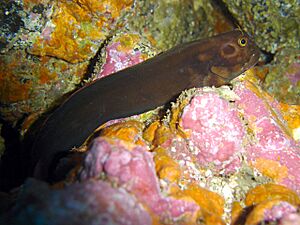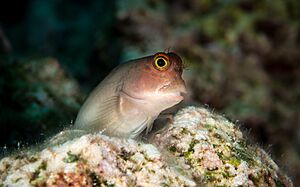Redlip blenny facts for kids
Quick facts for kids Redlip blenny |
|
|---|---|
 |
|
| Conservation status | |
| Scientific classification | |
| Synonyms | |
|
The Ophioblennius atlanticus, also known as the redlip blenny or horseface blenny, is a type of combtooth blenny. These small fish live mostly in the western central Atlantic Ocean. You can find them in shallow coral reefs.
Redlip blennies are very protective of their space. They will attack other fish that come too close. They use two long, sharp canine teeth to defend their homes. Adult redlip blennies usually live 10 to 20 meters deep. Their eggs stay on the bottom of the ocean. These fish can grow up to four inches long. They get their name from their big, reddish lips. Redlip blennies mainly eat algae.
Contents
About the Redlip Blenny
What's in a Name?
The redlip blenny was first described by a French scientist named Achille Valenciennes in 1836. The name Ophis comes from a Greek word meaning "serpent." Blennios is Greek for "mucus." The name atlanticus tells us where the fish was first found: the Atlantic Ocean. Its common name, "redlip," simply describes its reddish lips.
What Does It Look Like?
Adult redlip blennies are usually two to four inches long. They are often chocolate brown with some yellow spots. They have blunt heads with four branching horns. Their most noticeable feature is their large, reddish lips. Some redlip blennies are paler. They might have a shell-white body with a reddish-brown head.
Where Redlip Blennies Live
Ocean Homes
The Ophioblennius atlanticus lives in warm, tropical parts of the central Atlantic Ocean. In the eastern Atlantic, they are found from Senegal to Angola. This includes islands like the Canary Islands, Madeira, and the Azores. In the western Atlantic, they live near Bermuda and from North Carolina south through the West Indies to Brazil. They have also been seen a couple of times in the central Mediterranean Sea.
Redlip blennies prefer clear, shallow waters. They like areas with coral reefs and rocky bottoms. Adult redlip blennies typically live at depths of 10 to 20 meters. Their eggs are benthic, meaning they stay on the ocean floor.
Redlip Blennies as Pets
Sometimes, redlip blennies are kept as pets in aquariums. They need at least a 30-gallon tank. These fish are usually peaceful. They can live well with other fish, as long as those fish don't look too similar to them. They do best when kept in mated pairs.
The water in their tank should be kept between 22–26 °C (72–78 °F). The water's pH level should be 8.1–8.4. Redlip blennies can jump from one tide pool to another in the wild. This means you need a lid on their aquarium to keep them from jumping out! They mostly eat algae, but they also munch on tiny zooplankton and other small creatures. Their sharp canine teeth have earned them the nickname "devil fish" in some places.
Redlip Blenny Behavior
Reproduction and Life Cycle
Redlip blennies reproduce all year long. They mate in the ten days before and four days after each full moon. Males and females pair up early in the morning. The female then moves into the male's territory.
The male has to prepare a nest for the eggs. He clears a small, box-like space in his territory. He removes coral bits and dead algae. A male redlip blenny usually has about five nests. He spends more time at the nests that females like best. These favorite nests are often larger inside.
When a female enters a male's nest, she decides whether to mate with him. Larger males with bigger nests are more likely to successfully mate. During mating season, males eat less. The female lays her eggs in a single layer. The male then guards and cares for the eggs. He blows fresh water onto them until they hatch into tiny planktonic larvae.
A male redlip blenny might mate with several females. This means a single nest can have eggs from different mothers. Female redlip blennies also often lay eggs in multiple nests.
Choosing a Mate
Female redlip blennies choose males based on their "genetic quality" or "non-genetic quality."
- Genetic quality means the male has good genes. This is often shown by physical features that help him survive. For example, a big body size usually means good genes. Mating with a male that has good genes helps ensure the babies will also be strong and healthy.
- Non-genetic quality includes things like good parental care. Good care doesn't mean the babies will have good genes. But it does mean more of them might survive.
Female redlip blennies look for both types of quality. They often choose larger males (genetic quality). Bigger males can protect the female and the eggs better from predators. Larger males also have bigger organs that produce special substances. These substances help prevent microbial infections in the eggs.
Females also look at how well a male cares for eggs that aren't even his own (non-genetic quality). This "allopaternal care" shows the female that the male is good at protecting eggs. Older males might also be preferred. Their age can show they are good at surviving, which could mean better chances for the babies.
Parental Care
In many fish, the male does most of the parenting. Redlip blennies are no different. Male redlip blennies protect the eggs from predators. They also blow fresh water onto the eggs.
They also do something special: they rub a part of their body over the nest's inner surface. This part of the male's body produces substances that fight germs. This helps protect the eggs from infections, which are a common cause of death for young fish. Larger males have larger organs for this, so they can offer better protection. This is why females often choose bigger males.
Another unique thing is that male redlip blennies care for all the eggs in their nest, even if some aren't theirs. If a male takes over an empty nest, he will guard the eggs already there. This is called allopaternal care. It might seem strange for a male to care for other fish's babies. But it actually helps him! Having safe eggs in his nest shows other females that he is a good protector. It also shows he will be a trustworthy mate who will stick around and care for the babies.
Protecting Their Space
Redlip blennies are very territorial. This means they defend their living space. They protect resources like food, shelter, and places to lay eggs. They live among rocks and coral reefs on the ocean floor.
Redlip blennies are very aggressive towards other fish that live on the bottom. These other fish might try to take their shelter or nesting sites. They are most aggressive towards other redlip blennies. This is because other redlip blennies want the exact same things, leading to strong competition. Even if another redlip blenny just barely enters their space, they will show hostility. Because they are so territorial, redlip blennies that lose their homes have a very hard time finding a new one.
Sometimes, when there are fewer adult blennies around, many blennies will gather. They fight against the older residents to take over their territories. After these fights, the older residents usually end up with only half of their original space.
How Larvae Swim
Many fish have a swimbladder. This is a gas-filled sac that helps them float and swim. Redlip blennies, however, never develop a swimbladder. This doesn't bother adult blennies, as they are used to living on the sea bottom.
But young redlip blenny larvae are different. They are not comfortable living at the bottom yet. To survive, they need to float. So, redlip blenny larvae have a lot of lipids (fats) stored in their liver. This high amount of fat helps them float. They keep this fat until they grow up.
Later, as the larvae change into adult fish (a process called metamorphosis), they use up all their stored fat. This fat gives them energy for the big changes happening in their bodies. After metamorphosis, adult redlip blennies do not store fat in the same way. This makes their bodies denser, which is good for their bottom-dwelling life.



